Dirtside
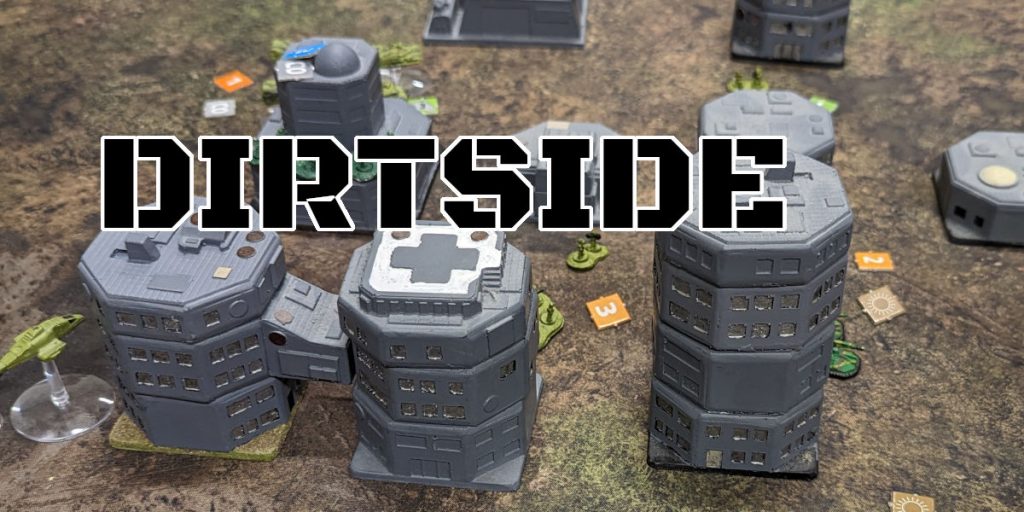
After our game of Stargrunt II a few weeks back (and several games of Full Thrust earlier), it was time to try the third of the Ground Zero Games systems and try out Dirtside II. All three exist in the same universe, though they are pretty much generic in terms of the rules themselves. Dirtside also has a lot of similarities with Stargrunt. It is effectively the 6mm version of the 25mm Stargrunt rules.
There were three players, so I designed a scenario for three armies. The idea was for a city defended by some local forces which was being assaulted by two invaders – an army of Neu Swabian League, and an army of New Anglian Confederation.
The board consisted of a central urban area, with two smaller urban settlements outside. There were also two wooded areas. There were seven objective markers across the board – one in each wood, one in each of the smaller settlements, and three in the central urban area.
Each objective was worth a point, and an army would gain points for each objective they controlled at the end of each turn. I had planned for a six turn game, though it didn’t quite work out like that.
One difference between Dirtside and Stargrunt is that Dirtside is a point based system, and has quite a complicated vehicle design system. As such, preparing for this game took a lot of effort. Unlike Full Thrust, which I already had designs for, Dirtside is a game I’ve played only maybe once or twice before, so didn’t have anything pre-designed.
Unlike Full Thrust, the ‘official’ GZG figures for Dirtside are also less well organised. There aren’t figures for each of the major nations, instead just a number of 6mm tanks and other military vehicles which can be used for any nation. This means I don’t have any armies for particular nations, just a random collection of figures with different paint schemes and styles.
I split the figures into three groups – grav vehicles, hover vehicles and and tracked. The tracked I setup as NSL, the grav vehicles as NAC and the hover as the local forces. The NAC and NSL were more or less balanced, with the local forces being a much smaller army.
Since I wasn’t feeling entirely comfortable with the rules, I wanted to play the locals more as an environmental threat than a full army, which meant I would have more time for checking the rules and overseeing what the other two players were doing.
Whilst Stargrunt is based until individual squads, Dirtside uses platoons as the main unit. A single platoon can consist for 3-5 vehicles, or a few infantry bases. The armies I setup were probably larger than I should have used for our first game – 6 for the NAC and 9 for the NSL.
Like Stargrunt, units have a quality and leadership score. Leadership ranges from one (good) to three (bad), and qualities are Green (D6), Regular (D8) and Veteran (D10). This cuts out the Yellow and Elite units which Stargrunt uses. Like that system, the quality denotes the type of die which is rolled. However, quality has less to do with actions than in Stargrunt.
Vehicles have a Fire Control rating which ranges from D6 to D10 in quality, which is the die type used for medium range attacks. At short range the die type is shifted up, at long range it is shifted down (so D6 to D4 for example).
Vehicles also have a Target rating, which is a Die type. Larger vehicles have a smaller Target die. Class 5 vehicles (the largest normal vehicles) have a Target Die of D4, Class 1 (the smallest) have D12. Targets can also have stealth ratings, which reduce their die type.
On an attack, if the Fire Control roll is higher than the Target Die, then it’s a hit. Weapons have a class – similar to Vehicles, from one to five. Damage isn’t done by dice roll – but by drawing chits. The class of the weapon defines one many chits to draw. Chits have a number – from zero to three. They also have a colour – 50% are red, 25% are green and 25% are yellow. There are also some special chits which represent system or mobility hits etc.
Each type of weapon defines what types of chits count. So High Energy Lasers (which turned out to be really effective) cause damage on Reds, and ignore Green and Yellow. Direct Fire Fusion Guns are short range weapons which cause double damage on all chit colours. The valid numbers are counted up, and if they exceed the armour value of the vehicle, then the vehicle is destroyed.
The base rules are pretty simple, but there are a lot of complexities around the edges. Some of it comes from the multiple different weapon types that are common on modern and futuristic battlefields. There are guided missiles, lasers, anti-infantry weapons, rocket salvos, artillery, aerospace vehicles and even rules for nuclear and biological weapons. Many of these I avoided for this game to try and keep things simple.
I think Dirtside is flexible enough to be used for modern combat as well as future combat. To be honest, the setting is pretty much modern warfare with the addition of some high tech things like grav vehicles and laser weapons. In the 30 years that the game has been published, there have been some changes to warfare, in particular the use of drones in the last few years. Drones are actually mentioned in Dirtside, but it is stated that it is assumed that both Drone and anti-Drone technology have both matured to the point where they have cancelled each other out. A similar assumption is made for electronic warfare.
The scenario started more or less as I’d expected, with both the NAC and NSL moving to take control of the outer objectives. The locals defended themselves, but didn’t initiative combat against the attackers. By the end of the first turn, both sides had claimed two objectives. I had been expecting to run a game of six turns, but this had already taken over an hour.
In the second turn, both forces moved in towards the central city. Urban combat is more dangerous than combat in the open. In the usual initiative order, each player gets to move one unit at a time, alternating between the forces. When a unit activates, it does everything – moves, shoots, makes confidence checks etc. Then a unit from the other side acts. The idea is so no player is left waiting for ages whilst the other side moves.
In close combat, both the engaged units fight until one is defeated. This is more deadly when vehicles are fighting infantry in an urban environment, especially since vehicles aren’t able to make use of their much greater weapon range.
By the end of the second turn, both NAC and NSL were equal, and the locals had lost control of most of the objectives. The NSL had control of more objectives, but had also lost their command unit so were down a point from that.
One mistake I made in the vehicle design was for the NSL VTOL gunboats I’d given them GMS/S (4). I presume I’d meant 4 x guided missiles, but that seemed way too high. I switched it to 2 to make it more sensible, but even this turned out to be very powerful. Going back to my design notes afterwards, it should have been GMS/L (1) – larger missiles, but one of them. Even with the superior area defences of the NSL, protecting against 8 missiles had been impossible (2 per Gunboat). If they’d only needed to protect against 4 (even if they were more powerful ones), then maybe their command unit would have survived.
The High Energy Lasers (HEL) were also powerful. With a range of 60″, they could strike from one end of the board to almost the other. I’d tried to arrange the terrain to block this, but there were angles of attack which the NAC were able to take advantage of. The NSL probably need to have ablative armour to reduce the effectiveness of lasers.
We ended the game after two turns. If it had gone on for longer, the NAC would probably have been able to push the NSL back with their higher tech forces.
I do need to go through the rules again to figure out the details which I was a bit sketchy about. Especially those involving close assault and missiles. There are differences between high and low modes for aircraft as well, which may have been useful to have used, but I was trying to keep things simple.
Overall, I think the game went well. There was still the fiddling with tokens that Stargrunt has, which is actually most complicated when tidying up at the end. I need to sort out the armies a bit better, and finish painting the figures that are still only partially painted. I also need to improve the painting on the buildings. They were given a rough coat of paint about twenty years ago, and haven’t been touched since.
Dirtside is hopefully a game we can come back to again at one point. As we learn the rules I think it’ll play better, and we’ll be able to bring in more features (orbital drop ships, artillery and aerospace vehicles for example).
I might also try to get some coloured dice especially for these two games. Red for d12s, orange for d10s, blue for d8s, green for d6s and yellow for d4s, to represent the unit quality colours.
The vehicle designs we used are written up on my Dirtside pages, but I really do need to go through these and update them now that I know the rules better.
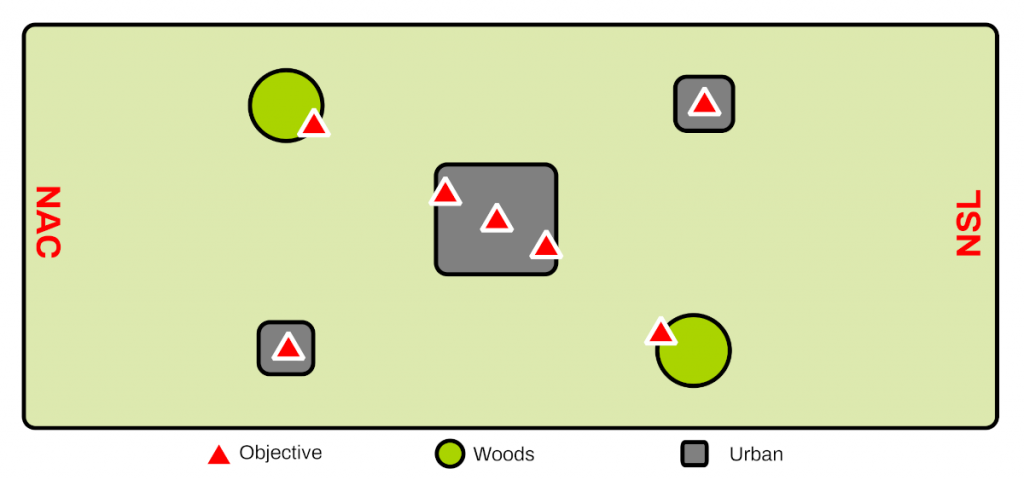
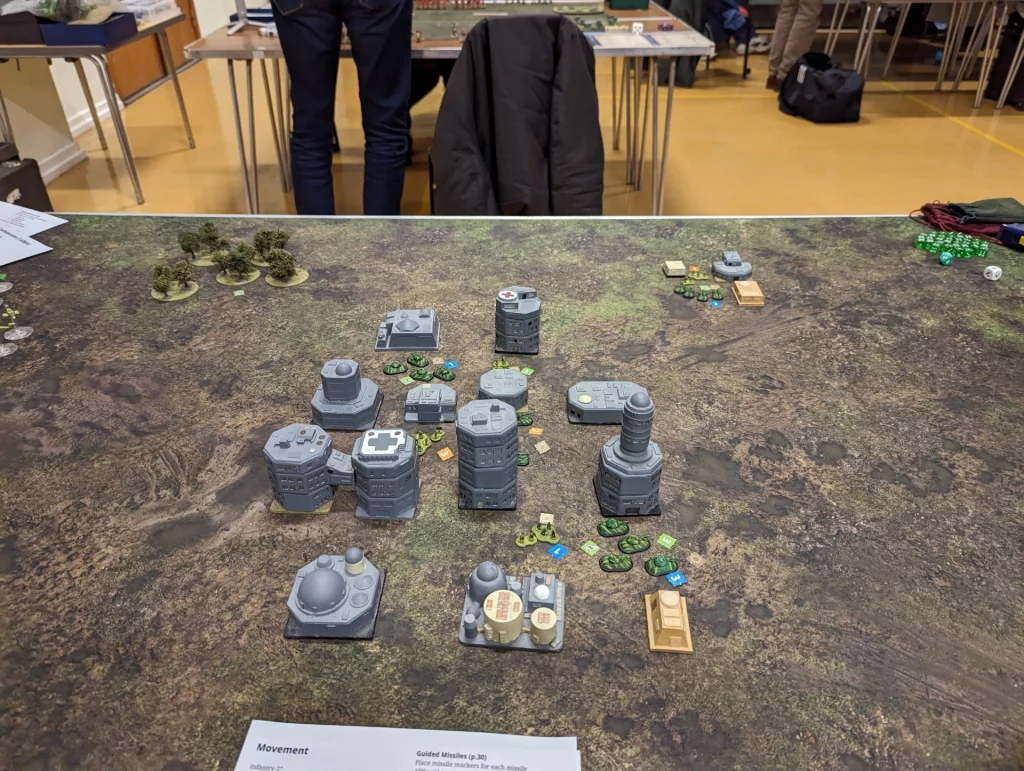
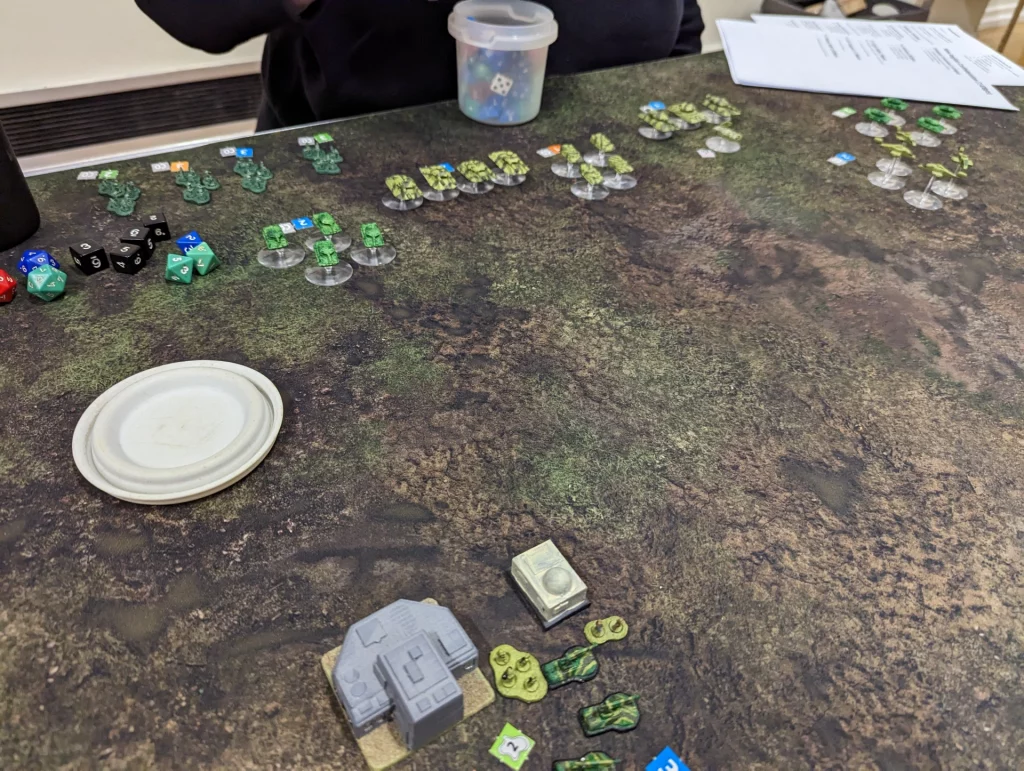
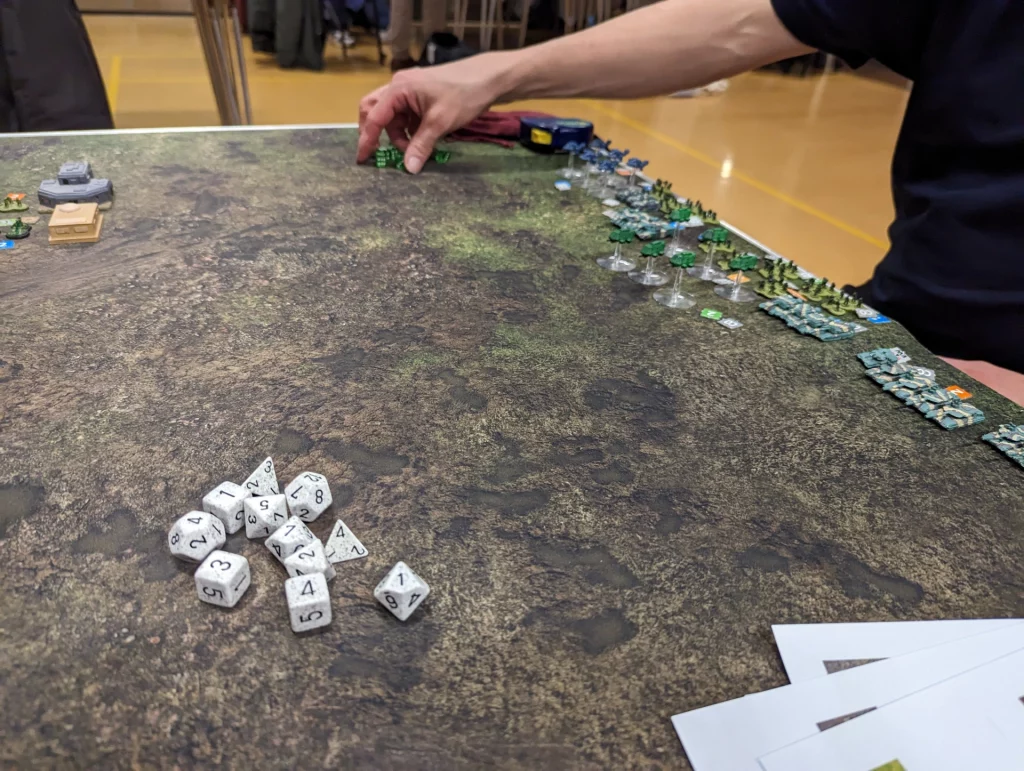
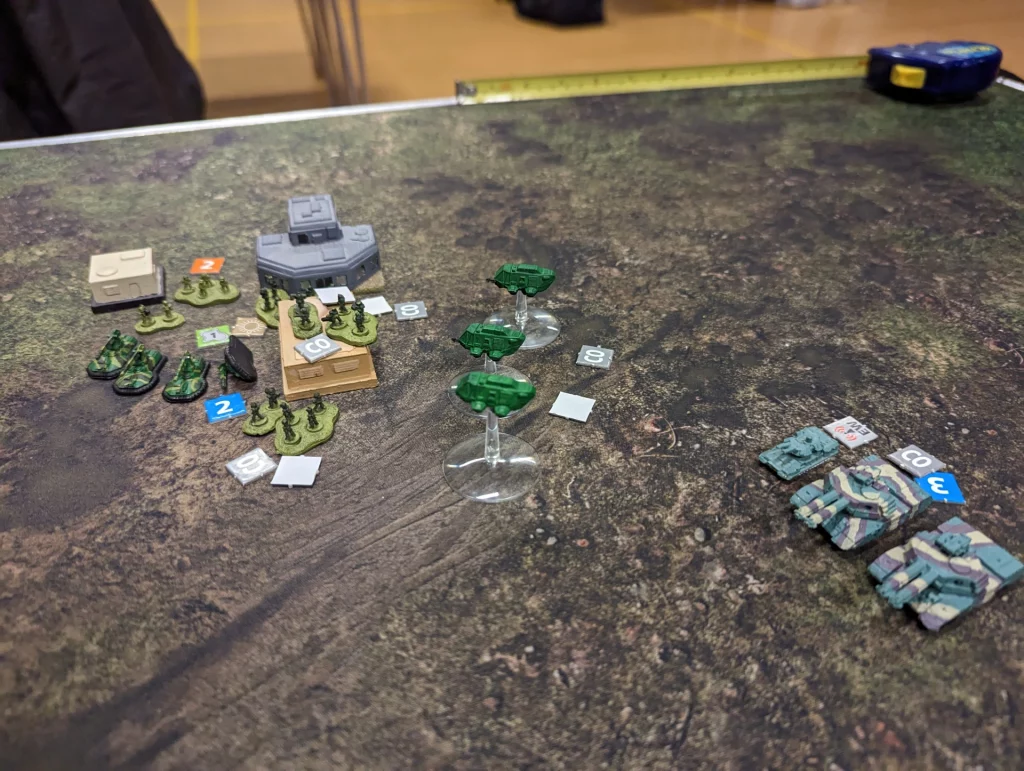
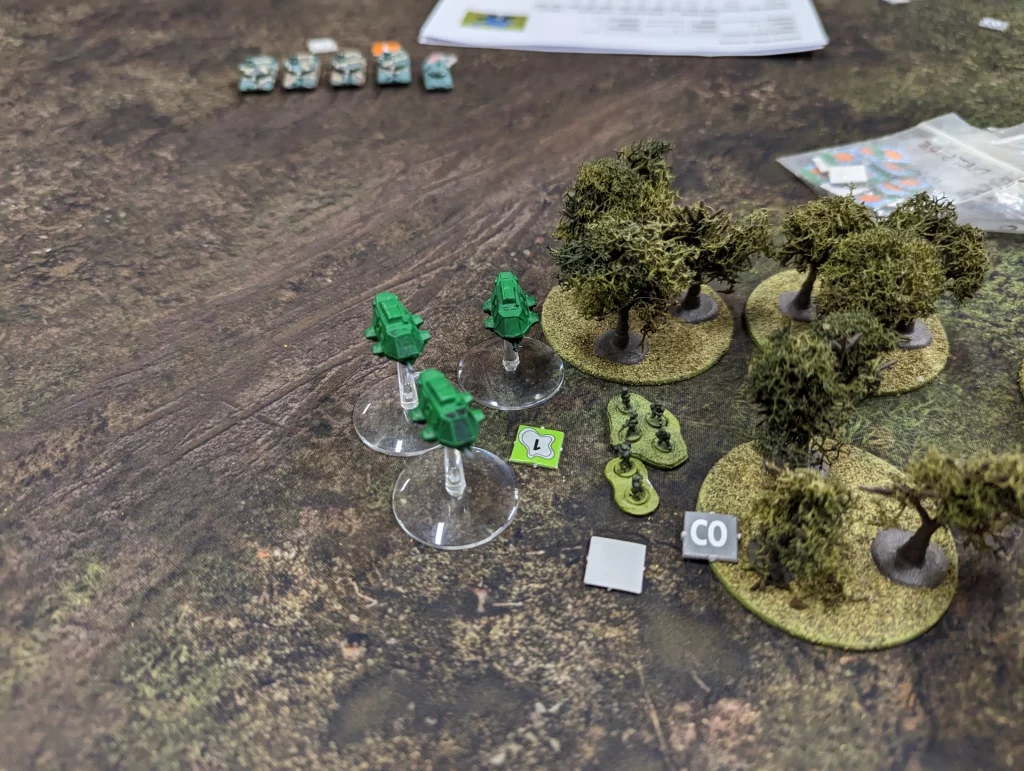
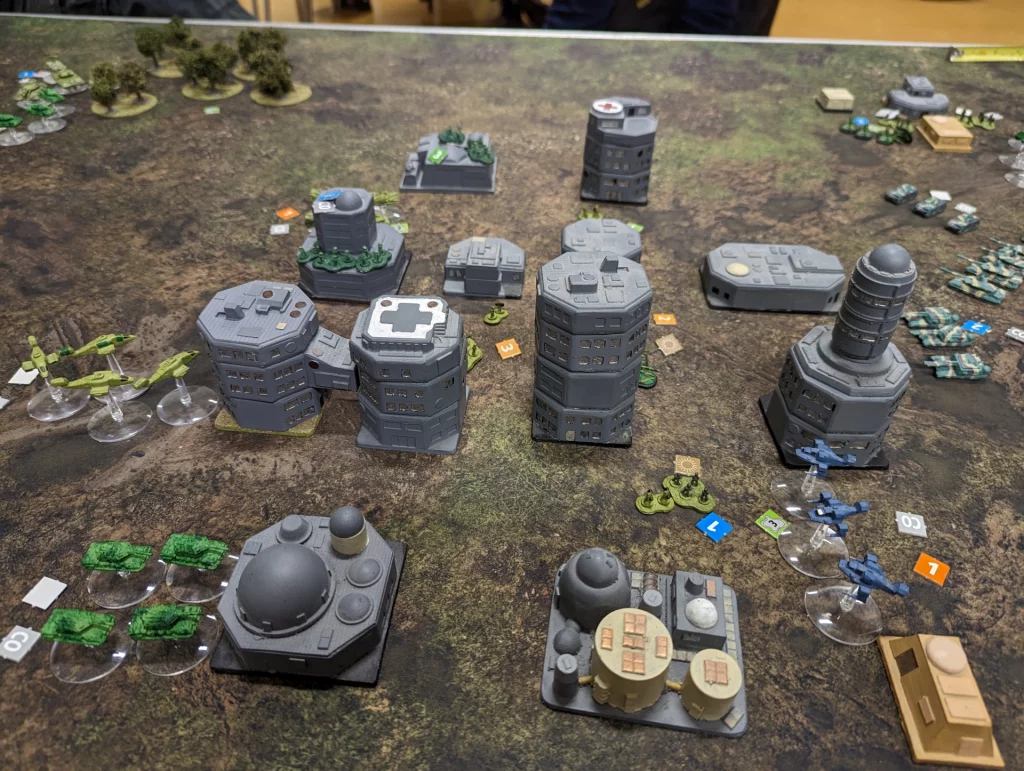
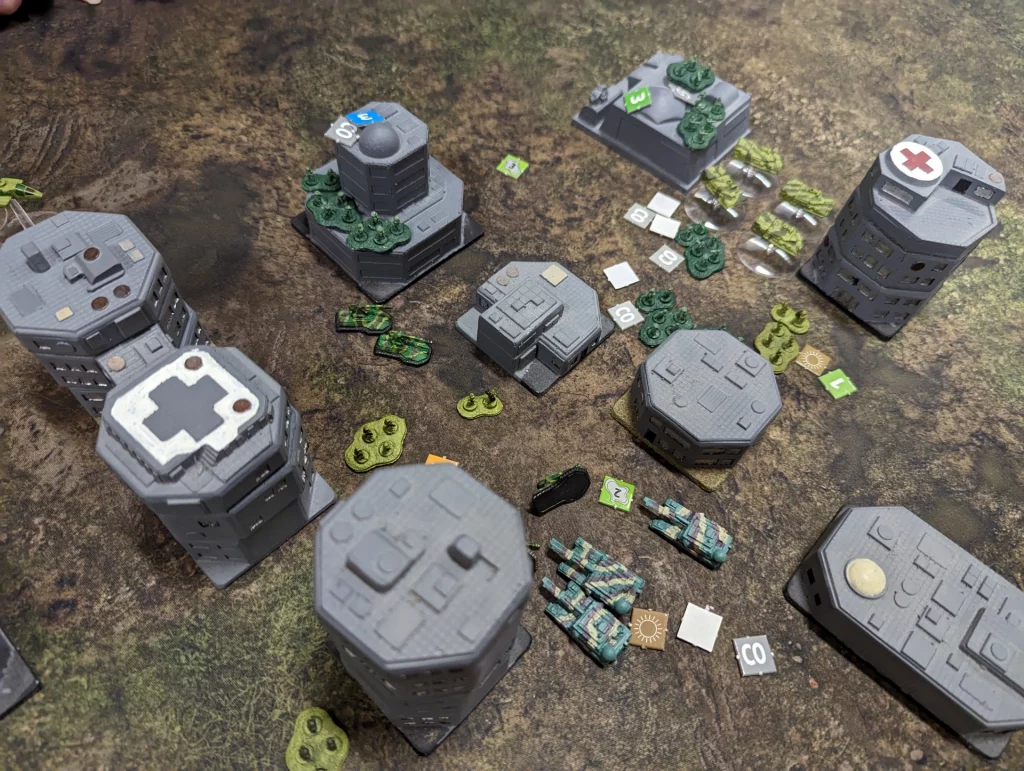
Nice battle report